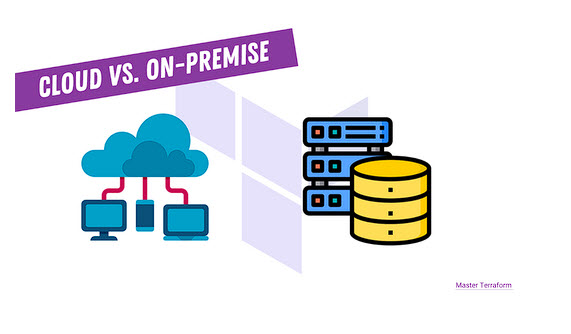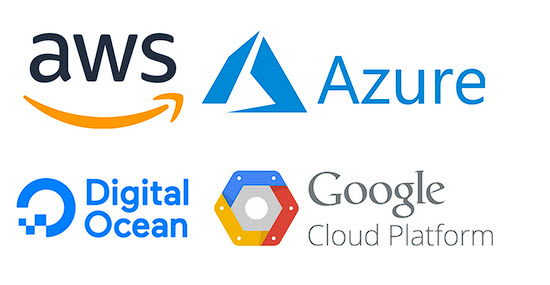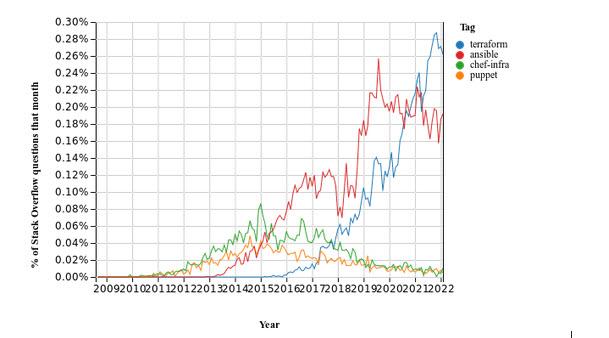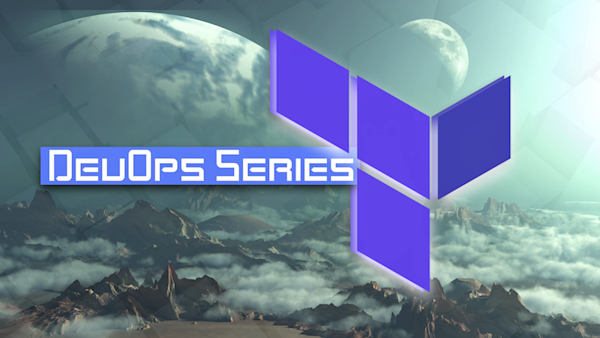Are you a DevOps Engineer who wants to automate your tasks and streamline your workflow?
If so, then Terraform may just be the tool for you!
In this article, we’re going to walk through exactly what Terraform is, along with the top 5 benefits when used as your IaC tool of choice.
So let's dive in.
What is Terraform?
Terraform is an Infrastructure as Code (IaC) tool created by Hashicorp for DevOps Engineers.
Similar to AWS CloudFormation, Terraform’s core use is to help you define both cloud and on-prem resources in human-readable files that you can version, reuse, config, automate and share.
Why should you use Terraform?
If you want to be efficient as a DevOps Engineer then you’re going to need tools that can automate most of your tasks, and that's exactly what Terraform helps you achieve.
Let me explain:
When it comes to building corporate network infrastructure there are two main possibilities: cloud and on-premise.
Essentially, the fundamental difference between cloud and on-premise infrastructure is where the infrastructure resides.

What is on-premise infrastructure?
With on-premise, everything is installed locally on your company's physical servers usually onsite or ‘on your premises’.
What is cloud infrastructure?
But with cloud infrastructure, rather than use your own servers, all networking resources are run and fully managed by third-party providers on their servers instead.

OK but what's the benefit of this?
Well I'm glad you asked!...
Cloud infrastructure vs on-premise: Which should you use?
In recent years the cloud has grown in popularity because the deployment process is much easier than on-premise.
Not only can cloud infrastructure scale easily to meet your demands, but you only pay for the resources you use, and without any physical infrastructure required by you.
For example
Imagine that your company needs to deploy a new application. Using the on-premise approach, the company needs to buy new hardware or upgrade the existing one to meet the new requirements.
Not only that, but you’ll probably have to purchase new software licenses, and then the DevOps team needs to install and configure both the hardware and the software for the new application. (And you'll probably need an Internet upgrade too.)
As you can imagine, this takes a lot of effort to get set up!
But if the company chooses to deploy the new application on a public cloud such as AWS, Azure, or GCP instead of on-premise, then they can bypass needing all these upgrades or even having to purchase them.
All you have to do is connect to your cloud account using the browser, select the necessary hardware resources from the service provider, click apply and you're done!
You pay only for the resources you'll use and if you don't need them anymore you can just terminate them with a click of your mouse.
It’s more cost effective, and you’re able to develop and deploy applications faster.
There is however a downside to cloud infrastructure…
The cloud seems simple to use but that's not the case, because you still have a lot of work to do to set it up.
You have to create tens of components, configure each component in a specific way and make sure that everything works together efficiently and securely.
This means you’re looking at maybe hundreds of mouse clicks! And just imagine that you have to do that on a daily basis. That's not fun, is it?
Fortunately, tools like Terraform make our lives a lot easier 😀.
How Terraform can improve your DevOps processes
Terraform allows DevOps Engineers to automate and manage the Data Center Infrastructure, the platforms, and the services that run on those platforms, all from one location, that you can reuse and share.
Instead of handling the infrastructure manually by logging into the AWS Web Console to create each component of your infrastructure, you just do it in code.
And if you need to change anything? Well then you just update the Terraform code and apply it, helping you to automate your cloud infrastructure and configuration.
What does ‘Infrastructure Automation’ mean?
When you think of infrastructure automation you normally think of provisioning, which means getting and setting the physical components required to run specific applications.
In this example though, we're referring to infrastructure automation as reducing the number of human interactions with an IT system.
We achieve this by creating scripts or functions with a tool like Terraform, so that they can be reused to save us time and effort.
We make it once and then use it again and again. Simple!
Now, when it comes to Infrastructure as Code (IaC) there are many popular tools:
- Terraform
- Ansible
- Chef
- Puppet
- SaltStack
- CloudFormation, and more
So why should you choose Terraform and not something else?
The top 5 benefits of using Terraform:
These are my top reasons why you should choose Terraform as the tool of choice when it comes to infrastructure provisioning and automation.
#1. Terraform is OpenSource, platform-agnostic and backed by HashiCorp
Terraform is an OpenSource Infrastructure as Code (IaC) tool, created by HashiCorp, a San Francisco-based company that is the leader in infrastructure automation for multi-cloud environments.
And because Terraform is platform-agnostic, it makes it the best Infrastructure as Code (IaC) solution to configure, test and deploy infrastructure across multiple cloud providers such as AWS, Azure, GCP, DigitanalOcean, and more.
This means that DevOps teams can use one unified, consistent solution to manage each of their cloud infrastructures.
And better still, Terraform is written in Go which is known as one of the most efficient programming languages.
#2. Terraform is Declarative
The Terraform language is declarative which means it describes an intended goal rather than the exact steps needed to reach that goal.
So Terraform itself is responsible for figuring out how to achieve that state without actually defining all the steps because the current state of the infrastructure is fully captured in the code.
State management is a key component of any long-term project, and Terraform keeps track of all changes in the environment.
#3. Terraform is Agentless
Most Infrastructure as Code (IaC) and automation tools are agent-based.
They require you to install agent software on each server that you want to configure.
The agent is typically running in the background on each server and is responsible for installing the latest configuration management updates.
But the beauty of Terraform is that it doesn’t require any software to be installed on the managed infrastructure.
This means that Terraform can be easily installed and used.
#4. Terraform uses a modular structure
Terraform modules are a powerful way to reuse code and stick to the "DRY" principle which means "Do Not Repeat Yourself".
What is a module in Terraform?
Terraform modules are comparable to functions in programming languages.
Using modules you'll have a standard interface for creating resources by providing inputs and returning outputs.
These modules will help you to organize configuration, encapsulate configuration, re-use configuration, provide consistency and ensure best practices.
And because you have the code in a single place and can import that code into different parts of your configuration, you'll also decrease the number of errors.
#5. Terraform has a large community with enterprise support options
When you pick a technology, you are also picking a community to help you learn or use that tool.
You might not think it matters, but the community ecosystem around a project can have a huge impact on your experience with that technology because it determines how many people contribute to the project, how many integrations and extensions are available, how easy it is to find help online on professional forums like StackOverflow, and how easy it is to hire a consultant if you need help.
This alone is a huge factor.
As you can see here on StackOverflow, the Terraform ecosystem is the most active of all IaC tools!

Terraform is a project with a growing community of active and dedicated users who are willing to help you out.
And if you need enterprise support you're covered too, as HashiCorp offers paid plans for larger teams that include paid features and additional support.
What's next?
So there you have it. Hopefully by now you know understand what Terraform is and the benefits of using it, and might even be thinking of giving it a try.
And if that's the case, then I have 2 recommendations for you.
You can either:
Jump on some free tutorials available on the official Terraform website, or you can follow along with my brand new DevOps Bootcamp on Terraform.
I know this is a biased recommendation, but I can honestly tell you that this bootcamp is one of the most comprehensive resources on Terraform.
I created it after personally completing hundreds of Terraform tutorials and then more importantly actually practicing it by using it on a daily basis. So you know you're learning from someone who actually uses the tool and not someone just teaching you off of the Terraform documentation!
You'll get not only video tutorials but tons of hands-on challenges and quizzes (with solutions) so that by the end of the course you'll have gained the skills you need to become a certified Terraform Associate and even be able to get hired as a DevOps Engineer or System Administrator.
And even better still, you don't have to learn alone because you'll have access to our online community on Discord. With 300,000+ members, there is always someone online that is happy and willing to help you on your Terraform journey!
Then, once you've learned Terraform and are ready to start applying for DevOps jobs that use it, check out my 53 Terraform questions and answers for the technical interview guide.
It will help walk you through some basic to advanced background information that you may be asked during your interview. Read the post, quiz yourself, and see how much you know!






